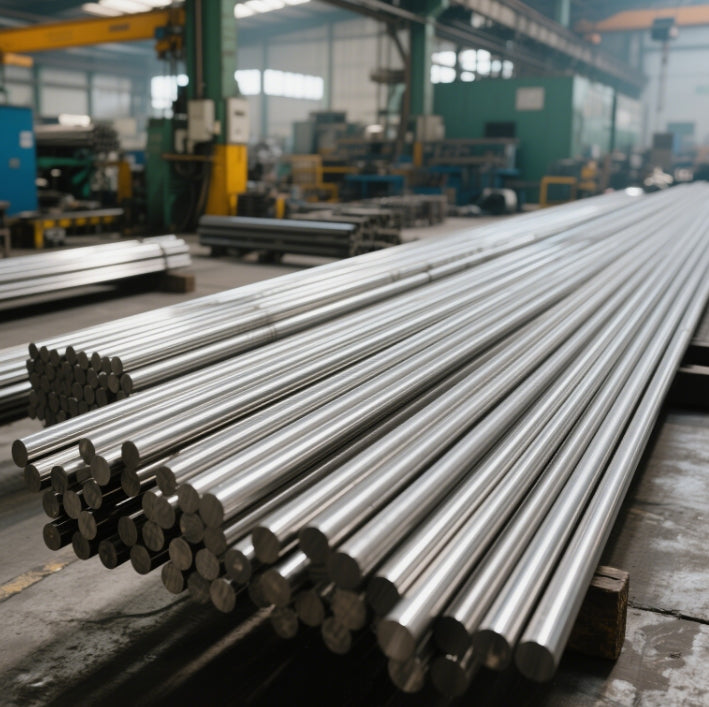StockSteel
Stainless Steel Rod for Construction | High Load Capacity
Stainless Steel Rod for Construction | High Load Capacity
Couldn't load pickup availability
Stainless Steel Rod for Construction | High Load Capacity
Product Specifications
| Parameter | Details |
|---|---|
| Material Grades | 316L, 304, 2205 Duplex, 17-4 PH (Customizable for stainless steel wire rod or stainless steel tig rods) |
| Diameter Range | Round Rods: 6–500mm; Threaded Rods: M6–M30; Wire Rods: 1.6–12mm (stainless steel wire rod) |
| Length | 0.1–12m (Standard), Custom Lengths Available (±0.1mm Tolerance) |
| Hardness (HV) | 150–250 HV (304/316L); 300–400 HV (Cold-Worked/Duplex Grades) |
| Tensile Strength | 520–860 MPa (304); 800–1,200 MPa (Duplex 2205); 700–1,000 MPa (17-4 PH) |
| Surface Finish | Polished (#4–#8 Mirror), Cold Drawn, Passivated, Electroplated (Optional) |
| Welding Compatibility | stainless steel tig rods (ER308L/316L), MIG, Laser Welding (stainless steel welding rod chart included) |
| Certifications | ISO 9001, ASTM A276, EN 10088, NACE MR0175 (H₂S Resistance) |
Mechanical & Chemical Properties
Tensile Strength
Our stainless steel wire rod (316L grade) achieves tensile strengths of 520–860 MPa, ideal for structural applications like bridge reinforcements and high-rise frameworks. The 2205 duplex grade combines austenitic-ferritic microstructures to deliver 1,200 MPa tensile strength, outperforming standard grades by 40% in chloride-rich environments such as coastal infrastructure. For precision components like seismic dampers, 17-4 PH rods (700–1,000 MPa) are heat-treatable to enhance hardness and dimensional stability.
Bend Strength
Bend strength ranges from 60–75% of tensile strength, optimized for dynamic loads in construction. For example, cold-drawn stainless steel tig rods (ER316L) exhibit bend resistance of 310–430 MPa, ensuring crack-free welds in steel-truss joints. Duplex 2205 rods provide 30% higher bend resistance than austenitic grades, making them suitable for offshore platform components exposed to tidal forces.
Identification & Marking
Stainless steel rods are labeled per global standards for traceability:
- ASTM A276: Specifies chemical compositions (e.g., 316L: 16–18% Cr, 10–14% Ni, 2–3% Mo).
- ISO 15510: Ensures compliance for marine and architectural applications.
- Laser Etching: Permanent markings include grade (e.g., "316L-860MPa"), batch number, and tensile class.
Weight Calculation
Weight (kg) = Volume (m³) × Density (7,930 kg/m³ for austenitic steel).
Example for a 10mm diameter, 1m rod:π × (0.005m)² × 1m × 7,930 kg/m³ ≈ 0.62 kg.
For stainless steel wire rod (12mm diameter):Weight ≈ 0.89 kg/m. Custom weights vary with alloy density (e.g., duplex 2205: 7,850 kg/m³).
Why Stainless Steel Rusts: Causes & Solutions
While stainless steel resists corrosion via a chromium oxide layer (≥10.5% Cr), specific conditions trigger rust:
- Chloride Exposure: Coastal saltwater or de-icing salts degrade passive layers. Use 316L rods with molybdenum for marine-grade stainless steel tig rods in bridge cables or seawalls.
- Galvanic Corrosion: Contact with carbon steel accelerates oxidation. Insulate joints using dielectric coatings or reference our stainless steel welding rod chart for ER309L filler metals.
- Mechanical Damage: Scratches expose iron. Passivate surfaces with nitric acid post-machining to restore chromium oxide layers.
- Low Oxygen Environments: Stagnant water in crevices (e.g., threaded joints) breeds crevice corrosion. Design gaps >0.5mm for oxygen flow.
Why Choose Our Stainless Steel Rods
- Certified Quality: ISO 9001 and ASTM-compliant production with third-party SGS/BV inspections.
- Precision Customization: Tailor stainless steel wire rod, tig rods, or threaded rods to exact dimensions (±0.1mm tolerance).
- Fast Delivery: 15–30-day lead time via DHL/FedEx, with bulk discounts for orders over 5 tons.
- Sustainability: 100% recyclable alloys; lean duplex grades reduce nickel consumption by 50%.
- Technical Support: Expert guidance on welding parameters (e.g., ER316L preheat: 150–200°C) and corrosion prevention.

